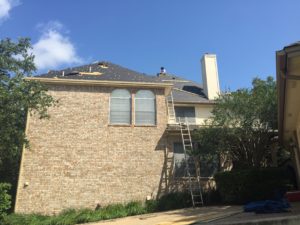 A roof’s primary function is to shield the contents and occupants of the structure from weather that could result in damaged furnishings and miserable living conditions. However, your roof also protects the structural components, including the flooring and floor joists, rafters, wall studs, exterior siding, and attic. A leak can cause damage that may be costly to repair, especially if the leak is hidden and goes undetected for many months. Experienced roofing contractors know that there are specific areas of any roofing system that are particularly likely to develop leaks. When performing an inspection or making a roof repair, a qualified roofing contractor will pay particular attention to these areas.
A roof’s primary function is to shield the contents and occupants of the structure from weather that could result in damaged furnishings and miserable living conditions. However, your roof also protects the structural components, including the flooring and floor joists, rafters, wall studs, exterior siding, and attic. A leak can cause damage that may be costly to repair, especially if the leak is hidden and goes undetected for many months. Experienced roofing contractors know that there are specific areas of any roofing system that are particularly likely to develop leaks. When performing an inspection or making a roof repair, a qualified roofing contractor will pay particular attention to these areas.
Where Do Roof Leaks Develop? | Austin, Texas
Roofs vary widely in architectural style and roofing materials. Vents and other penetrations also vary in type, number, and location. Therefore, your home may not have every feature shown below, but the list includes the areas that residential roofing contractors commonly identify as the source of a leak.
• Flashings: Flashings cover the places where your roofing system is penetrated or interrupted. For example, you will find flashing around your chimney and vents as well as where a roofing plane meets a wall. Cracked, missing or bent flashing can allow water to penetrate.
• Chimneys: It is typical for a roofing contractor to discover that a chimney is the source of a leak. Problems with the flashing can be the issue, but roof leaks can also develop if the mortar is damaged or the bricks are cracked. A missing or damaged chimney cap can be the issue as well. If you suspect a problem in this area, be sure to contact a contractor with the expertise to perform a high-quality chimney repair.
• Gutters: Many people are unaware that leaking, cracked, clogged or missing gutters can allow water to penetrate to the interior of the home. Gutters are supposed to carry runoff away from the walls and foundation. Damaged gutters can allow water to penetrate behind the siding, potentially causing damage to the siding, the wall supports and the insulation. Water may accumulate around the foundation and damage it, or the water may leak into the basement. Clogged gutters can overflow and cause similar problems, but if the water cannot flow away, it may also back up under the roof’s edges. This can damage the decking, trusses, and rafters, and the water may leak into the living space.
• Valleys: Valleys are the channels formed by the intersection of two of the roof’s sections or planes. There are several methods used to cover or seal valleys against leaks, but flashing is the most common. Regardless of the technique used, valleys are vulnerable to leaks.
• Roofing: More often than you might suspect, roofing contractors responding to a request for an emergency roof repair discover that the roofing material merely is worn out. Contractors also encounter many situations in which a minor roof repair was neglected until the damage became extensive. For example, asphalt shingles may lose their granules, be blown off by high winds or cracked by hail. Regularly scheduled routine maintenance and timely response to minor issues can help prevent many costly repairs.
If you need a respected, experienced Austin based roofing contractor, contact Alpha Roofing. We offer an extensive range of roofing services, including chimney repair, emergency roof repair, asphalt shingle installation, preventive maintenance programs and roof inspections. We also install skylights, flashing, and wood siding. We believe in providing you with all possible options so that you can make an informed decision. We are known for the excellence of our work, our dedication to customer service and our reasonable prices. We offer free quotes, so call 512-777-1086 or complete our request form online.
